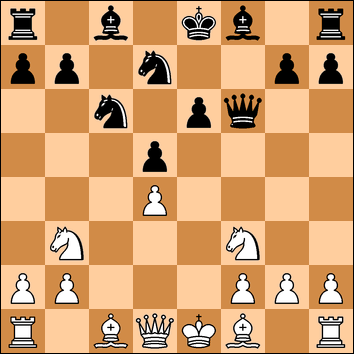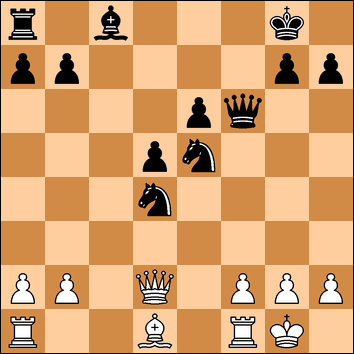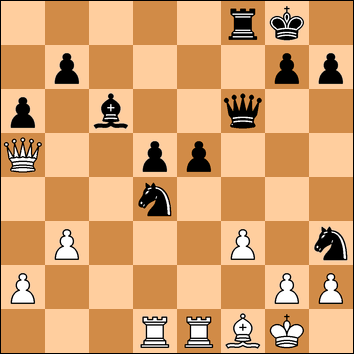Thursday 12 May 2016
White: K. Nevols (132) - Black: T. Owens (170)
Another tough opponent - and the leader of the championship. But I was slightly optimistic after securing a good draw in my last game.
1. e4 e6
The French defence. I had been researching to find a way to play against this popular defence for Black and decided to try the Tarrasch 3. Nd2.
2. d4 d5
3. Nd2 Nf6
4. e5 Nfd7
5. Ngf3
5. Bd3 is usual here with c3 and Ne2, or 5. c3 with f4 and Ndf3 to try to keep the e5 pawn. But I could not see anything wrong with my plan.
5. .... c5
Now 6. dxc5 is recommended. If 6. .. Bxc5 7. Nb3 Bb6 8. Bf4 or Nbd4 or even a4 - or 7. .. Be7 8. Bf4. If 6. .. Nxc5 then 7.Nb3. Maybe best is 6. ... Nc6 with 7. Nb3 Ncxe5.
Instead my move concedes the initiative at an early stage.
6. c3 Nc6
7. Nb3 cxd4
7. .. c4 8. Nbd2 f6 is interesting.
8. cxd4 f6!
A standard break in the French and a sign that Black is already better.
9. exf6 Qxf6

Now I make a mistake. White needs to get the kings' bishop developed and castled. So Be2, Bd3 or Bb5 are options here. Instead I notice the opportunity to develop while hitting the queen and completely overlook a check.
10. Bg5? Bb4+
And White should now just admit the mistake and play 11. Bd2 where Black could follow up with Qg6 or Bd6.
11. Nbd2 Qg6
White is considerably tied up and has to break the bind. I wanted to get my queen to the d3 square where it could add to the defence. I gave some thought to 12. a3 and also to 12. Qe2 where Black has the interesting 12. .. h6 13. Bh4 Qc2! (14. Qxe6+ Kf8 15. Qxd5 Qxb2 16. Rd1 g5 17. Bg3 Nf6).
Instead I chose a move which was visually pleasing. But 12. a3 was probably better.
12. Qb1 Qh5
13. Qd3 O-O
14. Be2?
After the game my initial thought was that I should have played 14. Be3 to withdraw the bishop out of harm's way. Black can then choose between 14. .. e5 or 14. .. Nf6. However the best move appears to be 14. O-O-O which breaks the pin, stops the Rxf3 trick, and gets the king out of the centre. Even then Black still has active plans with ides such as Bd6 and/or Nf6.
14. ... Rxf3!
15. Bxf3 Qxg5
Two pieces for the rook. The computer states that Black has now won - well, I am not finished yet.
16. Qe3 Qf6
Gobbling up a pawn.
17. O-O Bxd2
18. Qxd2 Nxd4
19. Bd1 Ne5!
Exploiting the fact that I can't take the knight on d4 because of Nf3+.

Now the game is resignable. Black has two formidable knights and a dangerous passed d-pawn. The only thing I can try to do is to hold off the immediate threats and get the rooks into the game.
20. b3
To prevent Nc4.
20. ... Bd7
21. Be2 a6
22. Rfe1 Rf8
23. f3 Ng6
The knights continue to circle like vultures. Another idea would have been 23.. Bb5. (24. Bxb5 Ndxf3+! or 24. Bd1 Nd3).
24. Rad1 e5
25. Qa5
Hoping to get the chance to infiltrate.
25. ... Bc6
26. Bd3 Nf4
27. Bf1 Nh3+!
Visually impressive and now finishing off in fine style.

28. gxh3 Nxf3+
29. Kh1 Qf4
30. Re2 d4
31. Rg2 Nh4
All Whites' moves are forced.
32. Qe1 Qxf1+
33. Qxf1 Rxf1+
34. Rxf1 Bg2+
35. Kg1 Bxf1
36. Resigns
A very impressive game from Black. Meanwhile, for me, it is back to the books to find out how to play against the French defence.
No comments:
Post a Comment